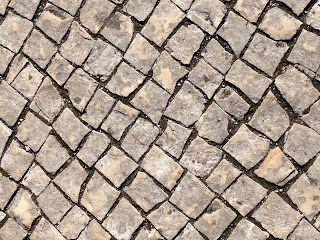The sidewalks -- that is the first thing I noticed when I stepped out of the hotel lobby onto Avenida Liberdade in Lisbon, Portugal -- the beautiful mosaic patterned sidewalks. On that first day of walking through Lisbon I think I did not even lift my eyes to look at the numerous monuments and cathedrals, Moorish castles, or perpetual blue skies that graced our weeklong visit -- because the limestone sidewalks were so beautiful. And the more we walked, the more varied and interesting the sidewalks became . . .
Most of the city's sidewalks were made by prisoners in the early 1800s. It was thought that the prisoners needed something to do with their time, and that the "something" ought to benefit the nation. Therefore, they were put to work creating much-needed walkways for a city that had been devastated nearly to extinction by a 9.0 earthquake and tsunami on November 1, 1755. It is a day still talked about by Lisboans -- their history, their art, and even items for sale in antique stores, are categorized as "before the earthquake" or "after the earthquake." I bought three beautiful tiles from "before the earthquake," that is, from 1750 -- "survivors," the store owner called them.
The Marquis of Pombal, the Secretary of State during the reign of Joseph I in the late 18th century, is much honored and credited with foreseeing the benefit of a "grid pattern" in rebuilding Lisbon after the earthquake. Nothing was left to the city but rubble and mud at that time, and so anything could have replaced it. The previous layout of Lisbon, like all medieval cities, had been designed on a circular pattern in which the city radiated out from a commercial "center" (from which our word city is derived).
At the time, The Marquis was criticized (or at least questioned) for making the sidewalks so wide. His response was, they may seem wide now, but someday they will be filled with people. Many monuments exist throughout the city to pay homage to this man with such foresight, but I admit I did not take a single picture of his monuments -- simply because I was taken up by the handiwork of his position, not by the man himself. Is this not the mark of a true leader?
The "Alfama" district of Lisbon was miraculously saved from total destruction during the 1755 earthquake. Therefore, the medieval winding walkways still exist. This is an area built primarily by the dreaded and overbearing Moors of the 9th and 10th centuries. History is filled with accounts of Portuguese struggles (battles/wars) to overcome Moorish rule. However, hated as the Moors were, their buildings -- and walkways -- were indestructible. These 1,000-plus-year-old walkways are still trodden by the likes of me today. One can spend a pleasant day tangled up in Alfama's winding streets while looking for Fado houses or family restaurants serving inexpensive lunchtime fare of salted dried codfish and local olives and pitchers of delicious Vinho Verde. I will always remember those meals -- and those inclusive pitchers of wine -- and the winding narrow walkways that would miraculously lead us out of Alfama and onto the familiar grid-like streets.
The walkways are made from a type of limestone, called "creme lioz," that is abundant in the nation. Each small tile, as they are called, is chiseled by hand and made to fit into the ground about two or three inches deep; it is made smooth on top, and placed into patterns like puzzle pieces. The tiles come primarily in two natural colors -- black and white -- though I have noticed (in the proximity of monasteries or cathedrals, at least) there is also a natural pink and a brownish-bronze.
I think one of the most profound traits of the Portuguese people is their natural inclination to give thanks. I noticed that people often greet each other by saying, Obrigado, or thankyou! They are thankful for the many miracles on which their country's legends are based, for their rich history, for overcoming Moorish dominance, for strong family ties, for the bounty of fish which the Atlantic Ocean provides, and for the beauty all around them.
Even the dogs seem to pay homage to the city's sidewalks by mimicking its native colors. I call this photo "Black and White." Only seconds after this photo was taken, the cute pup ventured to attack a white pit bull (unleashed) as it strolled by.
In a country deemed by economists to be one of the poorest in Europe, where unemployment staggers at 30 per cent, and where many educated men and women sleep on the sidewalks which I've shown -- there is art everywhere. One young woman, Margarida, who works three jobs to make ends meet (one of which is to conduct weekend walking tours for English speaking tourists), said, "I wish I could be a tourist in my own city. It is hard to make a living here, but it is beautiful!"


















